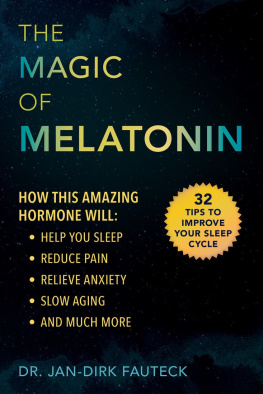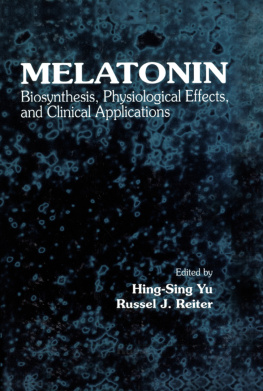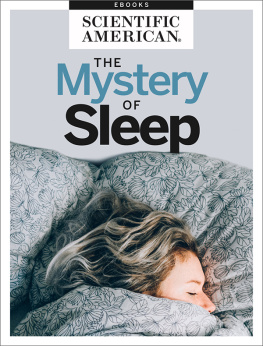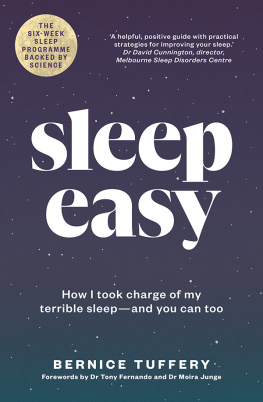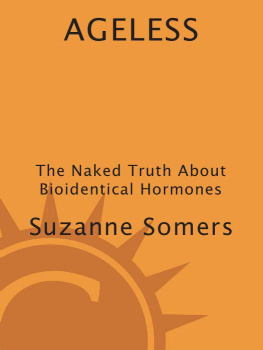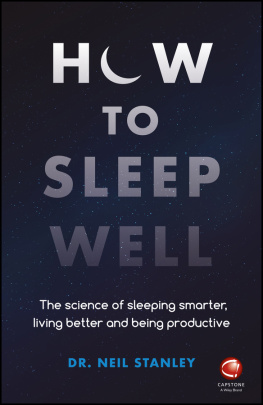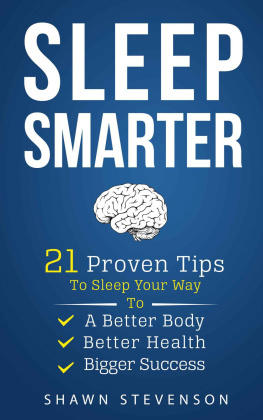


Copyright 2017 by Dr. Jan-Dirk Fauteck First English-language edition English-language translation copyright 2019 by Skyhorse Publishing Originally published in 2017 in Germany as MELATONIN: Das Geheimnis eines wunderbaren Hormons by Brandsttter.
All rights reserved. No part of this book may be reproduced in any manner without the express written consent of the publisher, except in the case of brief excerpts in critical reviews or articles. All inquiries should be addressed to Skyhorse Publishing, 307 West 36th Street, 11th Floor, New York, NY 10018.
Skyhorse Publishing books may be purchased in bulk at special discounts for sales promotion, corporate gifts, fund-raising, or educational purposes. Special editions can also be created to specifications. For details, contact the Special Sales Department, Skyhorse Publishing, 307 West 36th Street, 11th Floor, New York, NY 10018 or .
Skyhorse and Skyhorse Publishing are registered trademarks of Skyhorse Publishing, Inc., a Delaware corporation.
Visit our website at www.skyhorsepublishing.com.
10 9 8 7 6 5 4 3 2 1
Library of Congress Cataloging-in-Publication Data is available on file.
Cover design by Daniel Brount Cover photo by Getty Images
Print ISBN: 978-1-5107-4792-0
Ebook ISBN: 978-1-5107-4794-4
Printed in China
This book is dedicated to you by:
Chronoceuticals, by Chronobrands
CONTENTS
FOREWORD
In this book, Dr. Fauteck summarizes critical information related to the necessity of maintaining regular biological rhythms and succinctly describes the pathological consequences of circadian rhythm disturbancesand there are many such negative side effects. One of the most fundamental and best-known rhythms is that of melatonin. Disturbance of the melatonin cycle due to any reason interferes with the sleep-wake cycle, which leads to a number of other neurobehavioral and psychological problems. It is without doubt that the consequences of the loss of melatonin and its rhythm, which normally peaks at night, far exceed sleep problems. Ample melatonin has positive effects on the brain morphology and neuronal function, as well.
Unfortunately, in modern societies, a clear distinction between day and night no longer exists because of the widespread misuse of light at night, that is, light pollution. Light at night interferes with the ability of the pineal gland to produce and disperse melatonin. As a result, either no or a severely dampened melatonin rhythm exists in individuals exposed to artificial light during the normal dark time, which includes most people living in cities and in all individuals who work at night. This suppression of a distinct melatonin rhythm and all other biological cycles represents a serious perturbation of the biological clock of many organs, contributing to pathophysiology. Chronic perturbations of biological rhythms and the melatonin cycle have been tentatively linked to a variety of neurodegenerative disorders and to an increased cancer risk. Loss of neurons is often a consequence of excessive oxidative stress that can be prevented by antioxidants. Melatonin is an uncommonly effective antioxidant, so its reduction due to the exposure to light at night may have multiple negative health consequences related to the accumulation of oxidatively damaged molecules.
In addition to the loss of melatonin resulting from the exposure to light during the normal dark period, aging usually takes a severe toll on the biological clock and on melatonin production. The reduction in the ability of humans to produce melatonin begins some time during middle age, and it is often essentially absent from the blood of elderly individuals. The drop in melatonin with aging seems to be related to many debilitating changes associated with advanced age, for example, skin deterioration, cataracts, cardiovascular disease, cancer, and neurodegeneration.
Supplemental melatonin has been widely used to correct problems of sleep disorders; its benefit in these areas stems from its ability to regulate the circadian clock. Due to its actions as a potent antioxidant, melatonin may also have benefits that protect against the ravages of aging and many age-related diseases. Dr. Fauteck comprehensively and authoritatively reviews the extensive scientific literature that illustrates the potential benefits of the use of melatonin. Melatonin is a nontoxic molecule that has been widely used by humans for many years with very few adverse events being reported. Its side effects are essentially nil.
The book by Dr. Fauteck clearly describes how melatonin is produced and secreted, how the prevailing artificially imposed light/dark cycle can disturb its rhythm, and how this translates into other potential pathologies. The author does an excellent job in explaining the relationship between disturbed circadian rhythms and suppressed melatonin levels to disease processes at a level that will be comprehensible to all readers. This is a valuable and essential contribution to understanding the association among light and darkness, the biological clock, melatonin, and human health. This book will be useful to virtually everyone who reads it. The information it contains meets a very important unmet need.
Russel J. Reiter, PhD, Dr. h.c. mult.
San Antonio, Texas
INTRODUCTION
Our lives and bodies are determined by rhythms. We get up in the morning, eat several times a day, do various activities, and sleep at night. Melatonin, which is a hormone discovered only in the middle of the 1950s, is responsible for this rhythm control. Since then, it has made quantum leaps in its career as a subject of investigation and is a constant source of new, promising syntheses. Melatonin is known as the Swiss army knife (Reiter et al. 2014a) among hormones. It is a multifunctional talent with multifarious effects on our health, and it has long been a star hormone. But does it keep its promises?
Science agrees: melatonin as the multitasking hormone (Reiter et al. 2014a) has already surpassed all expectations! And there is still more to be expected, since the research is still in its infancy compared to the decades of intensive investigations of other body functions.
In addition to its sleep-aiding effect, melatonin protects our body against free radicals as a potent antioxidant and ensures a quality of life and mental fitnesseven in old age. It strengthens our immune system, lowers blood pressure and cholesterol levels, and can help prevent heart disease. Recent studies also demonstrate its excellent effectiveness in the treatment of cancer, diabetes, migraine, chronic pain, eye disease, and infertility, among others. Therefore, melatonin is a true force multiplier for our health.
Imagine your organs as an orchestra that only works perfectly through a collaboration under the direction of a gifted conductor. On the conductors desk is melatonin. Our body clock provides the rhythm and at night gives all the important body functions and organs the signal for regeneration. If our rhythm is no longer correct, our body is out of balance. This is a topic that has been the focus of chronobiology for about two decades. Thanks to this young science, we have recognized the importance of fine-tuning rhythms for our health and combating many diseases. Even now, chronobiology provides us with important physiological and pathological findings for individual medicine. However, much more is to be expected in the future of this field of study.

